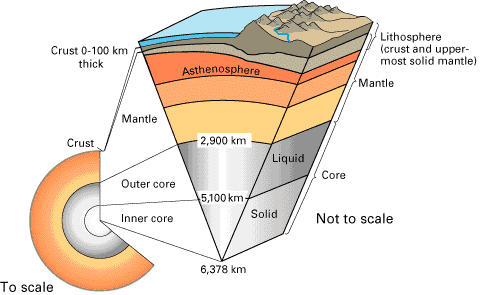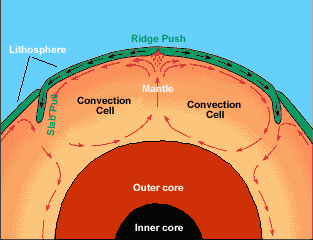Here is the vocabulary from our chapter and a few pictures to help you to review :) Remember that this is all recorded in your notes just the way that I wrote it on the board. You have learned SOOOOO much! Good work :)
(Double click images to enlarge them)
(Double click images to enlarge them)
- Seismic waves - waves that travel through the earth when there is an earthquake
- pressure - the result of force pressing on an area
- crust - the thin outer layer of rock around the earth. ~5-40 km thick
- basalt - the main rock found in the crust on the ocean floor
- granite - the main rock that makes up the crust in areas of dry ground
- mantle - the three layers between the crust and the core
- lithosphere - the top layer of mantle under the crust. It is hard like the crust is.
- asthenosphere - the middle layer of the mantle. It is hot and moves lie toothpaste.
- outercore - made of liquid molten metal. Mostly iron and nickel.
- innercore - made of solid hot metal. Mostly iron and nickel.
- radiation - the movement of heat through empty space
- conduction - the movement of heat through solids
- convection - the movement of heat through liquids and gasses
- density - the amount of mass in a certain amount of volume.
- convection currents - the movement of warm particles up while cold particles move down which creates a flow of material
- continental drift - the movement of the continents as the lithosphere slides on the Asthenosphere
- Pangea - the name given to the large land mass that is formed if all continents are together in one area
- fossil - the remains of dead plants and animals. Fossil remains provide evidence for the concept of continental drift.
- mid-ocean ridges - long mountain-like ranges under the ocean where new sea floor is created by magma.
- sonar - technology that uses sound waves to map the ocean floor
- sea-floor spreading - the continual growth of the ocean floor at the mid-ocean ridges which causes the continents to move
- deep-ocean trenches - the location of subduction near the coastlines of the continents
- subduction - the return of the ocean floor to the mantle near the coastline of a continent
- plate - the broken pieces of lithosphere that ride on the asthenosphere.
- scientific theory - a proposed idea that takes evidences into consideration in order to solve a problem
- plate tectonics - the theory that explains how the continents are able to move on plates due to convection currents in the mantle
- fault – the space between two plates
- divergent boundary – the edge of plates that are moving apart
- rift valley – A place in Africa where the plates are moving apart and creating a valley
- convergent boundary – the edge of plates that are moving together
- transform boundary – the edge of plates that are sliding past each other.


No comments:
Post a Comment
Thank you for commenting on our science class blog :)
Mrs. Tiday